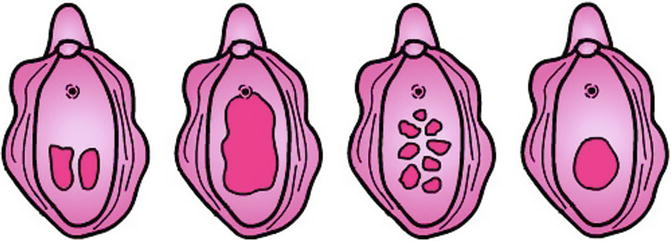

40” The treatment is surgical hymenectomy, which removes the obstruction. Posner concludes, “It can be surmised that if each older girl had undergone a complete examination of the genitalia as part of a routine well-child visit early in her life, then none would have had to endure the symptoms and diagnostic evaluations associated with late diagnosis. Almost half of the older patients were given an alternate diagnosis before imperforate hymen was discovered and 86% underwent unnecessary diagnostic evaluations such as blood work, urinalysis, and abdominal radiography. These older girls presented with abdominal pain, urinary symptoms, or both. Almost all of the younger patients were asymptomatic, unlike the older group where 100% were symptomatic at the time of diagnosis.
Hymenal tags series#
In younger girls, hydrocolpos may be noted on examination, which is a tense and gray-white appearing vestibule caused by the accumulation of vaginal secretions behind the imperforate hymen.Ī retrospective case series by Posner et al 40 of imperforate hymens found a bimodal distribution of age at diagnosis 43% were diagnosed at less than 4 years of age and 57% were not diagnosed until more than 10 years of age. Genital examination can reveal hydrometrocolpos, or a bulging, bluish vaginal mass that is caused by vaginal secretions and menstrual blood accumulating behind the imperforate hymen. Clinical symptoms in adolescents include primary amenorrhea and abdominal pain, which can accompany a midline lower abdominal mass on examination. 38, 39 Imperforate hymens are generally diagnosed as incidental findings in young females or later in adolescence when a girl remains amenorrheic despite age-appropriate breast and pubic hair development. Most commonly this is an isolated finding with an incidence that ranges from 0.014% to 0.1% in term births.

Imperforate hymen ( Figure 10-7) is a congenital anomaly in which the hymenal membrane has no functional opening and occludes the entrance to the vagina. Wallace MD, Michelle Amaya MD, MPH, in Child Abuse and Neglect, 2011 Imperforate Hymen Proper examination under anesthesia and forensic swabbing of affected areas should be undertaken with the use of a standardized protocol. The associated finding of a hematoma, abrasion, or laceration in combination with hymenal transection should raise the possibility of this diagnosis. 47.14).Īcquired abnormalities of the hymenal ring usually result from sexual abuse. In pubertal girls, general anesthesia with excision of excess hymenal tissue may be indicated ( Fig. Simple aspiration of the vagina without a definite drainage procedure should be discouraged because incompletely evacuated material may be prone to ascending bacterial growth. In newborns, repair by incision of the hymenal tissue at the bedside is performed in the transverse direction to avoid inadvertent extension of the incision anteriorly or posteriorly (which may injure the urethra or rectal structures). In these circumstances, a bluish bulging hymen may be observed on genital inspection and a mass will be appreciated on rectoabdominal palpation. On occasion, the diagnosis is not made until the adolescent period, when the patient experiences amenorrhea and possibly cyclic abdominal pain.

If the diagnosis is made after the neonatal period, the mucus often will have been reabsorbed, and a bulge in the hymenal membrane may no longer be evident.

The buildup of retained vaginal secretions in the neonatal period, which imparts a whitish appearance to the bulging hymenal membrane, is caused by maternal estradiol stimulation. The diagnosis is most frequently made at birth by noting the presence of a bulge along the posterior aspect of the introitus, which represents retained fluid within the vagina, or by palpation of a suprapubic mass from a distended vagina ( Fig. Imperforate hymen is probably the most common congenital obstructive anomaly of the female reproductive tract. Congenital abnormalities of the hymen are not uncommon and range from an imperforate hymen to one with numerous small microperforations. When symptomatic (i.e., bleeding), they should be excised to ensure that they do not represent a malignancy and to provide symptomatic relief.
Hymenal tags skin#
Hymenal skin tags are almost a normal finding and are rarely symptomatic ( Fig. Partin MD, PhD, in Campbell-Walsh-Wein Urology, 2021 Imperforate Hymen and Hymenal Skin Tags


 0 kommentar(er)
0 kommentar(er)
